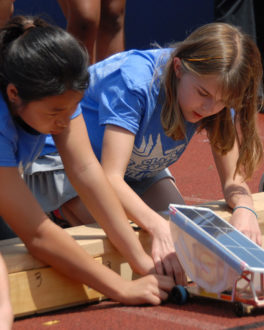April 7, 2017

By Stewart Wood, TSA Chapter Advisor
I have been a teacher for 23 years. In that time, I have found that there is nothing quite like working through a problem that generates that “a-ha” moment for students. It’s one of the reasons that after over two decades in the classroom, I am still passionate about being an educator.
For more than half my time as an educator, my classroom has also been a Junior Solar Sprint (JSS) site. JSS is a STEM program focused on exposing 5th through 8th grade students to ever-expanding science and technology fields including alternative fuels, engineering design and aerodynamics. Sponsored by AEOP and administered by the Technology Student Association (TSA), JSS attracts students to compete from across the country. My students use teamwork and problem-solving skills to design and build solar-powered cars. That means I witness “a-ha!” moments on a daily basis.
My students’ experiences with JSS have further reinforced my view of the importance of teaching problem solving. Students enjoy working with their hands and collaborating with friends on problems. Each group of students will establish a rank and file with the student best suited for a job taking the lead in that area and allowing those better suited to another part to carry that ball. There is conflict, challenge and even failure. But the students work through it, depending on their own inclinations, what they’ve learned and each other. They also learn which goals are “lofty” and unreachable and which are reasonable. They quickly find that if they jump into the project without first studying it, they will fail and have to start over. The moment when they figure out just the right combination of adjustments that makes the vehicle’s wheels spin like a jet shooting down the runway to take off—that’s incredibly rewarding.
As a teacher, it’s wonderful to weave excitement into my classroom. Of course, I think STEM topics are incredibly stimulating, but not all of my students agree at the start. Some take a bit of convincing. Being able to teach with the goal of creating the fastest, most interesting, and best crafted solar-vehicle possible assures my students of some serious fun.
But more than just fun, these activities are creating new possibilities for kids from all academic and socio-economic backgrounds. Our school is located in a community with a high proportion of low-income households. Between 93-97 percent of our students qualify as Title I. JSS facilitates career preparation and goal setting in these students in ways that other more cost-prohibitive programs or projects would not. By the time the students have completed their vehicle, they have worn the hat of many occupations: engineer, designer, graphic artist, machinist, manufacturer and manager.
The most important lesson that we take away is that when you approach a problem, you can take many different paths to reach the end of the journey. Students learn they shouldn’t give up if the first try—or second, or third—doesn’t lead to the outcome they wanted.
In my opinion there is no better way, outside of being on the job, to teach a student to understand what a career really is than to immerse them in real-world application, as we do in our JSS project. Problem-solving teaches students to be resilient and to look both inward and to their peers for the right tools. I can’t think of a more important life skill.
Find a Volunteering Opportunity
Visit our Program Volunteers page for a tool to find the best opportunity for you.
eCYBERMISSION Mini-Grant
The eCYBERMISSION Mini-Grant is intended to support teachers/program leaders as they implement eCYBERMISSION with their teams. Educators (formal and informal) of students in grades 6-9 are encouraged to apply.
